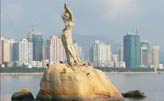Kaleidoscope
Space junk reaching 'tipping point,' report warns
Updated: 2011-09-02 09:33
(Agencies)
* Volume of orbital debris raises risk of collisions
* Collisions would create still more debris
* Orbiting junk threatens about 1,000 satellites
CAPE CANAVERAL, Fla - The amount of debris orbiting the Earth has reached "a tipping point" for collisions, which would in turn generate more of the debris that threatens astronauts and satellites, according to a US study released on Thursday.
NASA needs a new strategic plan for mitigating the hazards posed by spent rocket bodies, discarded satellites and thousands of other pieces of junk flying around the planet at speeds of 17,500 miles (28,164 kilomtres) per hour, the National Research Council said in the study.
The council is one of the private, nonprofit US national academies that provide expert advice on scientific problems.
Orbital debris poses a threat to the approximately 1,000 operational commercial, military and civilian satellites orbiting the Earth -- part of a global industry that generated $168 billion in revenues last year, Satellite Industry Association figures show.
The world's first space smashup occurred in 2009 when a working Iridium communications satellite and a non-operational Russian satellite collided 490 miles (789 km) over Siberia, generating thousands of new pieces of orbital debris.
The amount of orbital debris tracked by the US Space Surveillance Network jumped from 9,949 cataloged objects in December 2006 to 16,094 in July 2011, with nearly 20 percent of the objects stemming from the destruction of the Chinese FENGYUN 1-C satellite, the National Research Council said.
The surveillance network tracks objects approximately 10 centimeters in diameter and larger.
Some computer models show the amount of orbital debris "has reached a tipping point, with enough currently in orbit to continually collide and create even more debris, raising the risk of spacecraft failures," the research council said in a statement released Thursday as part its 182-page report.
"The current space environment is growing increasingly hazardous to spacecraft and astronauts," Donald Kessler, the former head of NASA's Orbital Debris Program Office who chaired the study team, said in a statement.
In addition to more than 30 findings, the panel made two dozen recommendations for NASA to mitigate and improve the orbital debris environment, including collaborating with the State Department to develop the legal and regulatory framework for removing junk from space.
Current international legal principles, for example, ban nations from salvaging or otherwise collecting other nations' space objects.
"The problem of space debris is similar to a host of other environmental problems and public concerns characterized by possibly significant differences between the short- and long-run damage accruing to society," the report said.
It cited "damage related to atmospheric concentrations of greenhouse gases, storage of nuclear waste and long-lived pharmaceutical residue in underground aquifers. Each has small short-run effects but, if left unaddressed, will have much larger impacts on society in the future," it said.
The study, "Limiting Future Collision Risk to Spacecraft: An Assessment of NASA's Meteoroid and Orbital Debris Programs," was sponsored by NASA.

Specials

Jewel of the south
Zhuhai in South China has a wealth of natural allure that is open for business.

China in vogue
How Country captured the fascination of the world's most powerful fashion player

More than just a game
Mahjong is a deep-rooted cultural tradition that touches every level of society